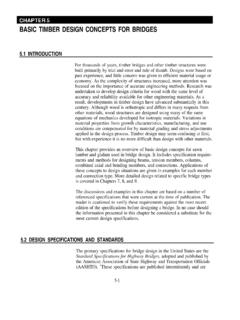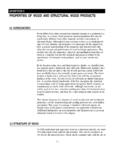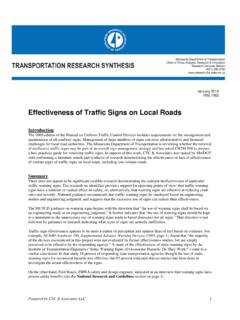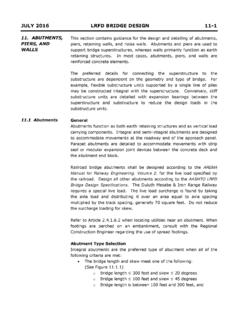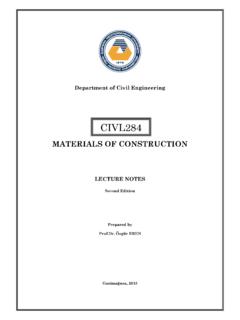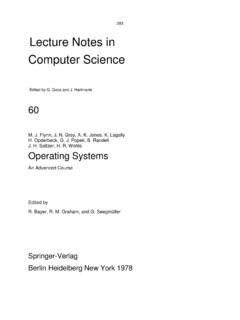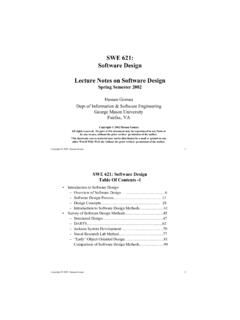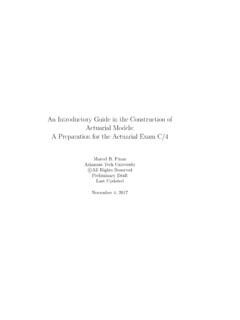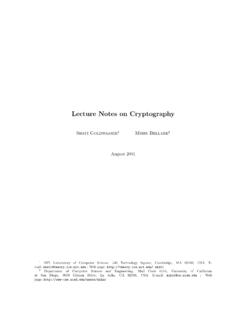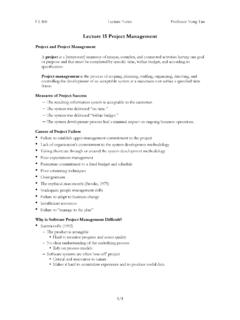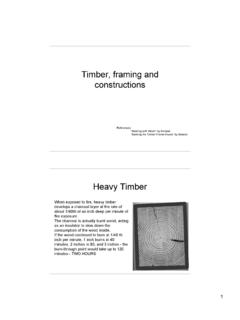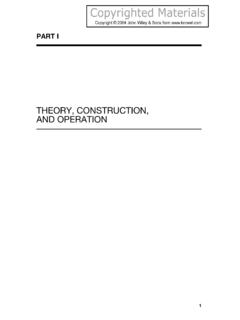Transcription of CHAPTER 4: EARTHWORK and SOILS & CONSTRUCTION …
1 Design Scene CHAPTER 4 ( EARTHWORK and SOILS & CONSTRUCTION notes ) Page 1 Revised 12-08-17 CHAPTER 4: EARTHWORK and SOILS & CONSTRUCTION notes 2106 EARTHWORK PAY ITEMS When using 2106 EARTHWORK pay items you cannot show any topsoil quantities. However, these quantities still need to be supplied to the central office estimating unit. Do NOT mix 2105 and 2106 pay items unless they are special 2105 items not covered by 2106. 2411 & 2451 STRUCTURE EXCAVATION CLASS Whenever 2411 & 2451 STRUCTURE EXCAVATION CLASS __ is included for structure excavation a note should be added stating something MATERIAL MAY NOT BE SUITABLE AS EMBANKMENT AND SHALL BE DISPOSED OF BY THE CONTRACTOR OFF THE PROJECT RIGHT OF SUITABLE AS EMBANKMENT ever applies to the projects situation.
2 BITUMINOUS REMOVAL The practice of removing 6 or less of bituminous pavement and paying for it with the common excavation pay item has been discontinued and is not allowed under the current specification. BRIDGE APPROACH TREATMENTS A reminder to designers that we should pay for the select granular material used for bridge approach treatments as detailed and noted on the standard plan sheets. This material is paid for as: SELECT GRANULAR BORROW ( ) CU YD and SELECT GRANULAR BORROW MOD 10% ( ) CU YD SELECT GRANULAR BORROW ( ) CU YD and SELECT GRANULAR BORROW MOD 10% ( ) CU YD ( ) = LV, CV, or EV *If the modified borrow is used it should be noted in the estimated quantities what the modification consists of.
3 CHECK EARTHWORK QUANTITIES Please ensure EARTHWORK design calculations are checked carefully. We have paid large claims due to plan errors in the EARTHWORK calculations. Make sure all areas are covered, the most common area of error is muck excavation. Check a few key areas by hand to confirm that the computer calculations are correct. Make sure that the areas in Geopac are labeled correctly. Design Scene CHAPTER 4 ( EARTHWORK and SOILS & CONSTRUCTION notes ) Page 2 Revised 12-08-17 CONSTRUCTION notes Pertinent CONSTRUCTION notes should be shown in the plan whenever possible, rather than included in the special provisions.
4 This makes it clearer and easier for the contractors bidding the job, as well as for our engineers, inspectors, etc. It is better to have as much information as possible shown in one document rather than having to refer to two of them, and the pertinent information is less likely to be overlooked while bidding the project or constructing it in the field. EXCESS MATERIAL The special provision recommendations governing disposal of waste materials and/or surplus excavated materials off the right of way are quite inconsistent. Some districts submit recommendations that cover such disposal vary comprehensively, while others are extremely vague.
5 Since protection of the environment, such as wetlands, has become so vital, we feel that standard comprehensive provisions should be established and used on all projects, state-wide, where disposal of materials off the right of way is required. It is recommended to use the MATERIAL NOT UTILIZED ON THIS PROJECT SHALL BECOME THE PROPERTY OF THE CONTRACTOR AND DISPOSED OF OFF THE R/W IN ACCORDANCE WITH SPEC 2104. NRHP-ELIGIBLE HISTORIC ROADSIDE PROPERTIES It is recommended that designers use the following note in CONSTRUCTION plans when their projects are located near NRHP-eligible historic roadside properties: Historic monument (Reference point XXX + ) is eligible for the National Register of Historic Places.
6 Absolutely no CONSTRUCTION staging, mobilization, material storage, CONSTRUCTION vehicle parking, or CONSTRUCTION -related activities of any kind to take place within 120 feet of the historic monument. PIPE JACKING When there is pipe jacking in the plan be sure to take into account how to handle the storage/placement of the excavated material from the jacking pit. If not sure what this should be assume for a 12 to 96 diameter pipe: Width = 3 times the pipe diameter Length = 2 times the pit width For larger pipe sizes, or box culverts, you would need larger or specially designed pits and should contact the district hydraulics office for assistance.
7 If the SOILS are particularly bad in an area, your pit width, and possibly length would also be greater because you would need a larger backing area to push against. Design Scene CHAPTER 4 ( EARTHWORK and SOILS & CONSTRUCTION notes ) Page 3 Revised 12-08-17 PIT DATA Gravel pits shown in the plans as possible sources of natural materials are causing some problems and delays in the processing of plans and special provisions for bid-letting. In many instances pits are listed in the plans with expired leases and other pits where leases are being negotiated. Gravel pits should not be shown in the plans unless there is current lease to cover the approximate contract time.
8 In the past, several projects had to be pulled from the letting because the contractor had obtained an exclusive right to the granular source. This results in unfair competition and/or high bid prices. If the designer has information or suspects that there will only be 1 source of material, he should contact the Right of Way people so the state can get a lease for the pit. The District Materials Engineer or the Aggregate Engineer should be able to assist the designer in determining if there is a chance that a contractor can tie up the only source of material. To alleviate these problems, it is suggested that the designer, six to nine months prior to the letting, notify the District R/W Engineer of the gravel pits that will be listed for the project.
9 This would allow them time to check the lease and other necessary pit information. The designer should submit this information to the Special Provisions Engineer at the time the plan is submitted. This information should consist of the following: Pit Number Indicate if the pit is State owned or has an exclusive lease or nonexclusive lease. Lease expiration date. Current price of materials in cubic yards, cubic yards compacted volume and ton. Any special conditions of the lease that may affect the contract or contractor. Pit data may be shown on one of the first three (3) sheet of the plans. If it is shown farther back in the plan it makes it difficult to find, and the necessary pit information may not be include in the special provisions for the project and may require an addendum to correct.
10 SUBGRADE EXCAVATION If it is the intent of the project to pay for the subgrade excavation as part of the common excavation a note should be included in either the SOILS notes , estimated quantity table, or tab sheet. It should state something All excavation shall be paid for as excavation-common.
